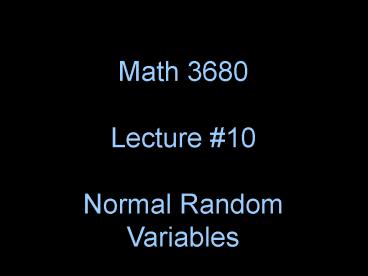Math 3680 - PowerPoint PPT Presentation
Title:
Math 3680
Description:
Title: PowerPoint Presentation Last modified by: allaart Created Date: 1/1/1601 12:00:00 AM Document presentation format: On-screen Show (4:3) Other titles – PowerPoint PPT presentation
Number of Views:83
Avg rating:3.0/5.0
Title: Math 3680
1
Math 3680 Lecture 10 Normal Random Variables
2
- Many distributions follow the bell curve rather
well. For example, according to studies, the
height of U.S. women has the following data m
63.5 inches and s 2.5 inches - Accordingly, about 68 of women have heights
- between 61 and 66 inches.
3
- However, the bell curve does not model all data
sets well.
4
- Example What percentage of women has heights
between 60 and 68 inches?
5
- Example What percentage of women has heights
between 60 and 68 inches? - Is this answer exact or an approximation?
6
- Example For a certain population of high school
students, the SAT-M scores are normally
distributed with m 500 and s 100. A
certain engineering college will accept only high
school seniors with SAT-M scores in the top 5.
What is the minimum SAT-M score for this program?
- Note Before, the kind of question that was
posed was What percentage of students score
above 700 on the SAT-M? Now, the percentage is
specified.
7
(No Transcript)
8
- Approximating a Binomial(n, p) distribution with
a normal curve
9
- Example From a heterozygous cross of two pea
plants, 192 seeds are planted. According to the
laws of genetics, there is a 25 chance that any
one offspring will be recessive homozygous,
independently of all other offspring. - Find the probability that between 44 and 55
(inclusive) of the seeds are recessive homozygous.
10
- Solution 1 (Exact). Let X denote the number
of recessive homozygous offspring. Then - X Binomial(192, 0.25)
- Therefore,
11
In terms of the probability histogram
12
- Solution 2 (Approximate). Note that the
probability histogram of the Binomial(192, 0.25)
distribution is approximated well by a bell
curve. Since - X Binomial(192, 0.25),
- we have
- We convert 43.5 and 55.5 to standard units
13
- Solution 2 (continued)
- Therefore,
- Question Why did we standardize 43.5 and 55.5?
- This subtlety is called continuity correction.
14
BBinomial(n, 0.5) distribution
15
BBinomial(n, 0.5) distribution
16
BBinomial(100, p) distribution
17
BBinomial(100, p) distribution
18
BBinomial(n,p) distribution with p small
19
- Limitations On Normal Approximation
- The normal approximation is reasonable if n is
large and both p and 1 - p are not small.
More precisely, the approximation is good if - n p ? 5 and n (1 - p) ? 5.
- What happens if n is large and p is small?
- What if instead p is close to 1?
20
- Continuity Correction
- The primary difficulty with using the continuity
correction is deciding whether to add or subtract
0.5 from the endpoints. This decision may be
facilitated by drawing a rough histogram and then
deciding which rectangles are to be included. - Example In the previous problem, what should be
converted to standard units to find - P(24 ? X ? 30)
- P(31 lt X ? 38)
- P(X gt 25)
- P(X ? 37)
21
- Continuity Correction
- Theres nothing particularly special about the
binomial distribution for this procedure. - The continuity correction can be used whenever a
discrete random variable is being approximated by
a continuous one.
22
- Example A gambler repeatedly bets on red in
roulette. The chance of winning on one play is p
9/19. Suppose the gambler plays 100 times. Use
the normal approximation to estimate the
probability that the gambler wins more than 50
times.































